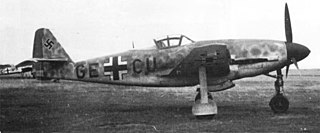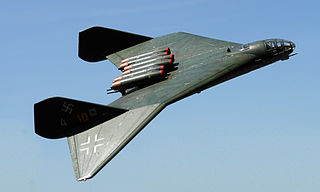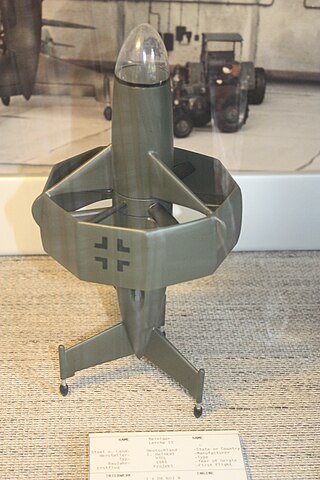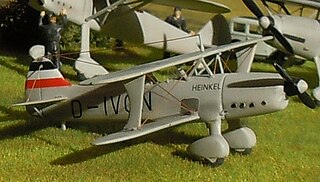Related Research Articles

The Messerschmitt Me 309 was a prototype German fighter, designed in the early years of World War II to replace the Bf 109. Although it had many advanced features, the Me 309's performance left much to be desired and it had so many problems that the project was cancelled with only four prototypes built. The Me 309 was one of two failed Messerschmitt projects intended to replace the aging Bf 109, the other being the Me 209 of 1943.

The Messerschmitt Me 609 was a World War II German project which joined two fuselages of the Me 309 fighter prototype together to form a heavy fighter.

The Heinkel HeS 011 or Heinkel-Hirth 109-011(HeS - Heinkel Strahltriebwerke) was an advanced World War II jet engine built by Heinkel-Hirth. It featured a unique compressor arrangement, starting with a low-compression impeller in the intake, followed by a "diagonal" stage similar to a centrifugal compressor, and then a three-stage axial compressor. Many of the German jet-powered aircraft designs at the end of the war were designed to use the HeS 011, but the HeS 011 engine was not ready for production before the war ended in Europe and only small numbers of prototypes were produced.

The Focke-Wulf Fw 57 was a prototype German heavy fighter and fighter-bomber. Prototypes were built in 1936 but never entered production.

The Arado E.555 was a long range strategic bomber proposed by the German Arado company during World War II in response to the RLM's Amerikabomber project. The E.555 designation was applied to a series of long range jet bomber designs of various sizes, powerplant, crew and weapon load configurations. As design studies only, no aircraft were developed or constructed and the entire E.555 project was cancelled at the end of 1944.

The Henschel Hs 124 was a twin-engine heavy fighter, attack aircraft and light bomber designed in Nazi Germany. After two prototypes had been built, work on the project was cancelled.

The Heinkel Lerche was the name of a set of project studies made by German aircraft designer Heinkel in 1944 and 1945 for a revolutionary VTOL fighter and ground-attack aircraft.

The Focke-Wulf Fw 56 Stösser was a single-engine, parasol monoplane advanced trainer, built in the 1930s in Germany.
The Focke-Wulf Project I was a design study for a jet fighter, to be built in Germany during World War II. In 1942, the Reichsluftministerium (RLM) asked Professor Kurt Tank of the Focke-Wulf factory to investigate the possibility of a single-engine jet fighter. He was given the development plans of the BMW 003, Jumo 004 and Heinkel HeS 011 engines. Late in 1942 the Project Office, led by Ludwig Mittelhuber, began to work on a series of fighter projects, to be powered by one of these new turbojet units.
The Focke-Wulf Project II was a design study for a single-seat jet fighter, carried out in Germany during World War II.
The Focke-Wulf Project III was a design study for a jet fighter, carried out in Germany in June 1943. It aimed to reduce the risk of foreign object damage to the engine that had been foreseen for the Project II, by relocating the engine from beneath the fuselage to a position atop the fuselage, with the jet intakes at the fuselage sides. In most other respects, it was similar to Project II, but as well as the engine relocation, Project II's conventional tail was replaced with twin tails on the ends of the horizontal stabiliser, in order to provide a path for the jet exhaust.

The Focke-Wulf Flitzer was a jet fighter under development in Germany at the end of World War II.

The Heinkel He 74 was a light fighter aircraft developed in Germany in the early 1930s. It was a conventional, single-bay biplane with staggered, unequal-span wings braced with an I-type interplane strut. The pilot sat in an open cockpit, and the undercarriage was of the fixed, tailskid type.
The Focke-Wulf Fw 43 Falke - known internally to Focke-Wulf as the A 43 - was a light utility aircraft developed in Germany in 1932. The last project undertaken by the company under the technical direction of Henrich Focke, it was a high-wing strut-braced monoplane of conventional design, with fixed tailwheel undercarriage. The pilot and two passengers sat in a fully enclosed cabin. Only a single example was built.
The Focke-Wulf Fw 47 Höhengeier, known internally to Focke-Wulf as the A 47, was a meteorological aircraft developed in Germany in 1931. It was a parasol-wing monoplane of largely conventional design, unusual only in the expansiveness of its wing area. Tested first by the Reichsverband der Deutschen Luftfahrtindustrie, and then the weather station at Hamburg, the type was ordered into production to equip ten major weather stations around Germany.

The Arado Ar 77 was a German twin-engined monoplane, designed as an advanced training aircraft from 1934.

The Albatros L102 / Albatros Al 102, was a German trainer aircraft of the 1930s. It was a parasol-wing landplane, seating the student pilot and instructor in separate, open cockpits. A biplane floatplane version was also built as the Al 102W, with strut-braced lower wings.

The Focke-Wulf Volksjäger, meaning "People's Fighter" in German, was a German emergency fighter project for the Luftwaffe. It was designed by Focke-Wulf industries towards the end of World War II as part of the defense effort against the devastating Allied bombing raids.
The Focke-Wulf Nr. 238 Fernkampfflugzeug was a four-engine strategic bomber developed by the German aeronautical company Focke-Wulf-Flugzeugbau AG in the early 1940s and remained at the project stage. Designed to the same specifications issued by the Reichsluftfahrtministerium (RLM) which led to the Focke-Wulf Ta 400 and Junkers Ju 390, its development was cancelled by the RLM.
References
- ↑ "German Military Aircraft Designations (1933-1945)".
- ↑ Lepage, Jean-Dennis. Aircraft of the Luftwaffe, 1935-1945: An Illustrated Guide.
- ↑ "Various Focke-Wulf projects". 24 July 2006.
- ↑ Dan Sharp; Secret Projects of the Luftwaffe: Jet Fighters 1939-1945, hardback, Mortons, 2020.
- Lens, K.; H. J. Nowarra (1964). Die Deutschen Flugzeuge. Munich: J F Lehmans Verlag.
- Masters, David (1982). German Jet Genesis. London: Jane's Publishing.
- Nowarra, Heinz (1983). Die deutsche Luftrüstung 1933–1945. Bonn: Bernard and Graefe. pp. Teil 2, p.117.
- Schick, Walter; Ingolf Meyer (1997). Luftwaffe Secret Projects: Fighters 1939–1945 . Hinckley: Midland Publishing. pp. 55–56. ISBN 9781857800524.
- Smith, J. R. (1973). Focke-Wulf: An Aircraft Album. London: Ian Allan.
- Smith, J. R.; A. Kay (1972). German Aircraft of the Second World War. London: Putnam.
- Wagner, Wolfgang (1980). Kurt Tank: Konstruckteur und Test Pilot bei Focke-Wulf. Munich: Bernard and Graefe.